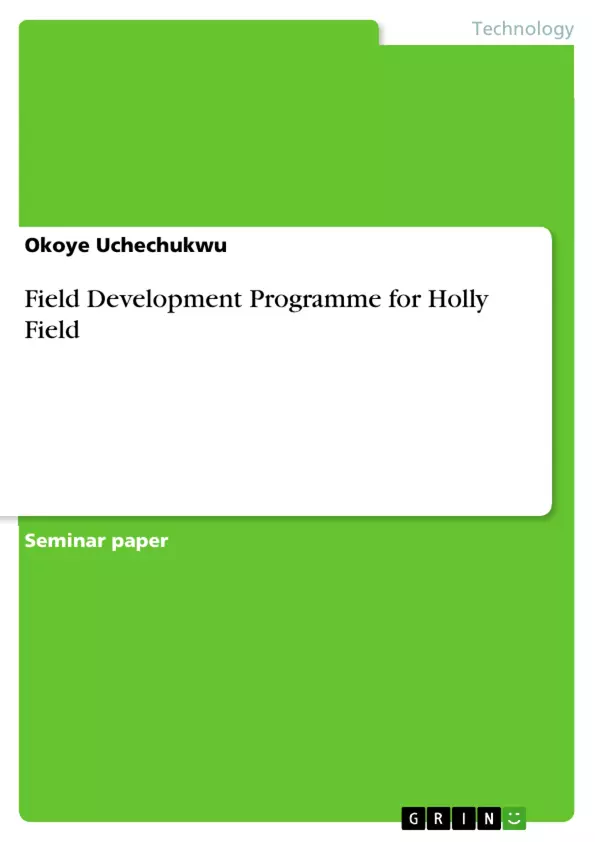This report presents the development plan for Gazelle gas condensate reservoir.
The viable development option for the field and the main items of equipment selected for the chosen option were presented.
The field development option was selected after analysing two different options:
1. Use of FPSO with shuttle tanker and
2. Steel Piled Jacket with pipelines based on technical viability, cost and commerciality aspect.
Based on these and some assumptions made, the development of the field using Steel Piled Jacket and pipeline for gas and condensate export was selected.
With this option, transportation of condensate to Fort Thompson is done via pipeline and export of gas to Fort Thompson, Gazelle and other fields is also achieved via pipelines.
The major components of the facility development project will include Piled jacket, drilling module, the fluid processing equipment such as separators, glycol dehydration units, gas turbines, centrifugal pumps and compressors, orifice and turbine meters.
Inhaltsverzeichnis (Table of Contents)
- Executive summary
- 1.1 Rotary drilling
- 1.1.1 Hoisting system
- 1.1.2 Circulating system
- 1.1.3 Rotating system
- 1.2 Process of rotary drilling
- 1.3 Criterion for land rig selection
- 2.1 Well planning
- 2.1.1 Well kick
- 2.1.2 Lost circulation
- 2.1.3 Selecting of casing setting depths
- 3.1 Pore pressure gradient
- 4.1 Cement additives and cementing
- 4.1.1 Lightweight additives
- 4.1.2 Retarders
- 4.1.3 Accelerators
- 4.1.4 Heavyweight additives
- 4.2 Cementing calculations
- 5.1 Selection of casing setting depths
- 5.1.1 Bottom-top design
- 5.1.2 Top-bottom design
- 6.1 Bottom Hole Assembly (BHA)
- 6.1.1 Drill bit
- 6.1.2 Mud motor
- 6.1.3 Measurement while drilling (MWD)
- 6.1.4 Logging while drilling (LWD)
- 6.1.5 Non-magnetic drill collar (NMDC)
- 6.1.6 Drilling jars
- 6.1.7 Drill collars
- 6.1.8 Stabilizers
- 6.1.9 Subs
- 26.2 Drill collars calculation
- 7.0 Well completion
- 7.1 Objective of bottom top design
- 8.0 Well schematic
Zielsetzung und Themenschwerpunkte (Objectives and Key Themes)
This report aims to present a comprehensive development plan for the Holly field exploratory well. The report focuses on well planning and design, providing crucial engineering support for optimal drilling operations. The key themes explored in this report include:- Rotary drilling systems and their application in the Holly field well.
- Well planning considerations, including pore pressure, fracture pressure, and casing setting depths.
- Cementing operations, including the use of additives and cementing calculations.
- Bottom Hole Assembly (BHA) components and their functions in drilling the final hole section.
- Well completion strategies and the rationale for bottom-to-top design.
Zusammenfassung der Kapitel (Chapter Summaries)
The executive summary provides an overview of the Holly field exploratory well development program, highlighting the key aspects of well planning and design. Chapter 1 discusses the rotary drilling system, outlining the functions of the hoisting, circulating, and rotating systems. It also examines the criteria for selecting a land rig suitable for the project. Chapter 2 delves into well planning, focusing on aspects like well kick, lost circulation, and the selection of casing setting depths. Chapter 3 explores the importance of understanding pore pressure gradients for successful and safe drilling operations. Chapter 4 examines the role of cement additives in casing cementing, including lightweight additives, retarders, accelerators, and heavyweight additives. It also presents cementing calculations, determining the volume of cement slurry and mud required for displacement. Chapter 5 discusses the methods for selecting casing setting depths, comparing the advantages and disadvantages of bottom-top and top-bottom design approaches. Chapter 6 details the components of the Bottom Hole Assembly (BHA), including the drill bit, mud motor, measurement while drilling (MWD), logging while drilling (LWD), non-magnetic drill collar (NMDC), drilling jars, drill collars, stabilizers, and subs. It also includes calculations for determining the number of drill collars required to achieve a specific weight on bit. Chapter 7 explores the objectives of bottom-to-top design in well completion, emphasizing its advantages and suitability for the Holly field well. Chapter 8 presents a schematic diagram of the well, showcasing the casing and cementing details.Schlüsselwörter (Keywords)
The report focuses on key concepts in oil and gas engineering, particularly those related to exploratory well development. Key terms include: rotary drilling, well planning, pore pressure, fracture pressure, casing setting depths, cementing, additives, bottom hole assembly (BHA), well completion, and bottom-to-top design.- Citar trabajo
- Okoye Uchechukwu (Autor), 2014, Field Development Programme for Holly Field, Múnich, GRIN Verlag, https://www.grin.com/document/300250



